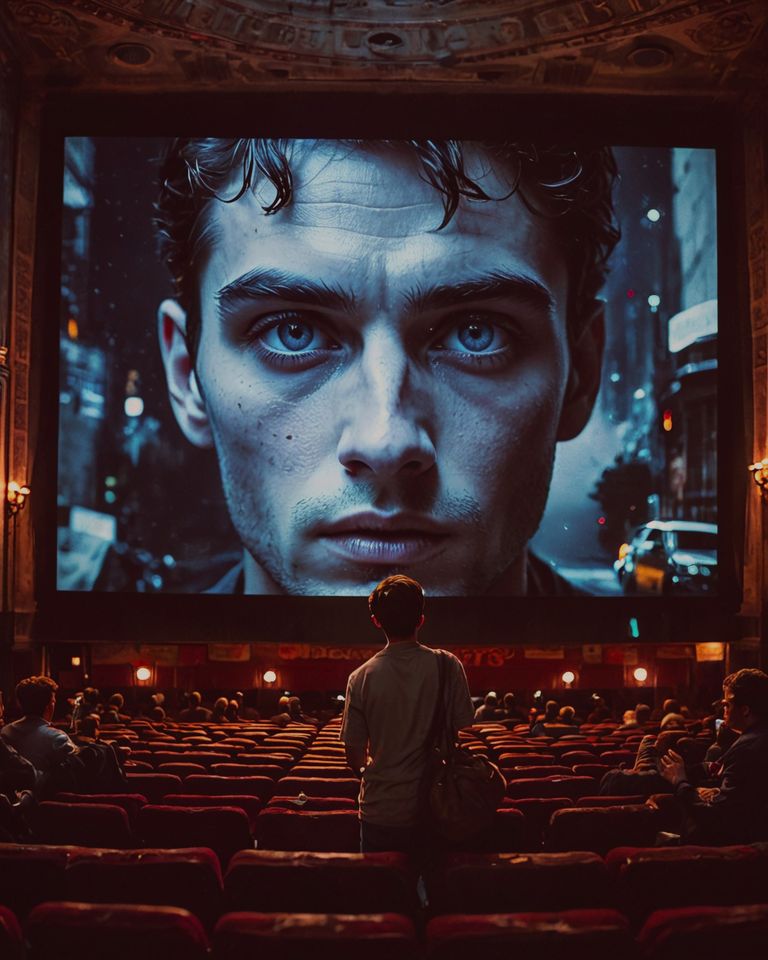
For as long as I can remember, the old cinema "La Estrella" has been my refuge, a place where dreams were projected on the big screen and reality faded away for a couple of hours. Its time-worn facade still retains a special charm; the red brick walls and flashing neon letters tell stories of laughter, tears and shared moments. Every corner of that cinema is impregnated with memories that connect me with my roots and with my family.
My Saturdays were sacred. My grandfather Manuel, a lover of classic cinema, used to take me to see the films that marked his youth. I remember how we entered the cinema together, he with his leisurely gait and I excited, almost running towards the box office. The smell of freshly made popcorn greeted us like a warm hug. The red velvet armchairs, although a little worn, were comfortable and cozy. As the light dimmed and the projector began to turn, I felt that each film was a window to another world.
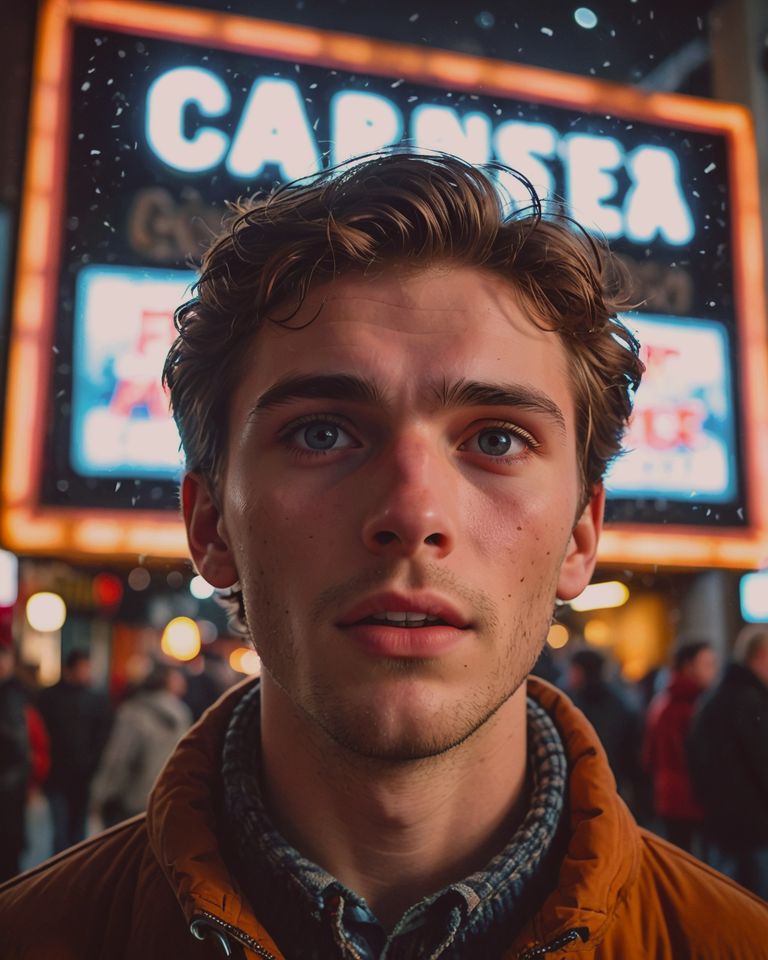
One day, while going through old photographs of the home theater, Lucas, my friend since childhood and a technology enthusiast, surprised me with a news that would change everything. "Clara," he said with a twinkle in his eye, "they've opened a new multiplex in the mall. They have IMAX screens and reclining seats. You have to go!". The emotion in his voice was contagious, but at the same time I felt a twinge of nostalgia. What would happen to "The Star"? Could a new cinema compete with the memories he had created there?
Determined to explore this new cinematic experience, I decided to invite my friends to join me: Sofia, a brilliant film critic and always ready to share her incisive opinions; and Javier, a lover of classic cinema who was reluctant to leave the old theaters. Together we agreed to visit the new multiplex on a Saturday afternoon.
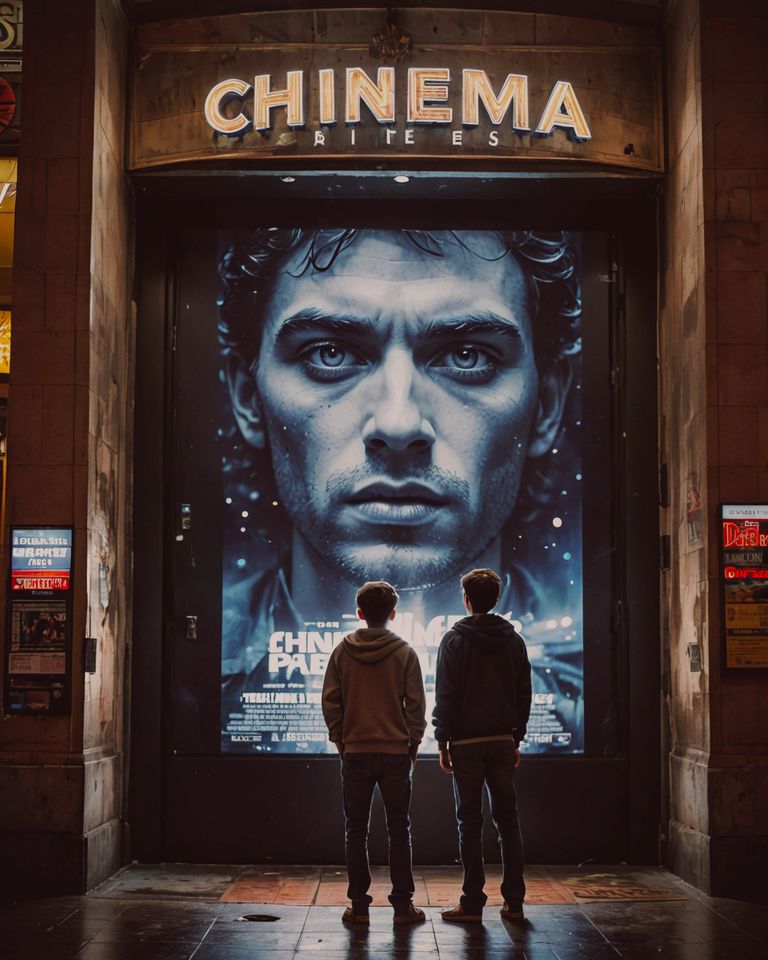
When I arrived at the mall, my expectations were high but also full of doubts. The entrance of the multiplex was imposing; huge illuminated posters advertised the latest Hollywood movies. As I walked through the automatic doors, I found myself in a spacious and Moderna lobby where everything seemed designed to impress. Long lines to buy tickets had been replaced by automated machines that issued tickets in seconds. A large digital screen showed the schedules of the performances and the trailers of the films.
"This is awesome," Lucas said as he settled into his reclining seat in the screening room. I looked around; the seats were comfortable and spacious, but something was missing. Javier frowned seeing how everyone was engrossed in their phones before the movie started. "I don't know... there is no soul here," he muttered scornfully.
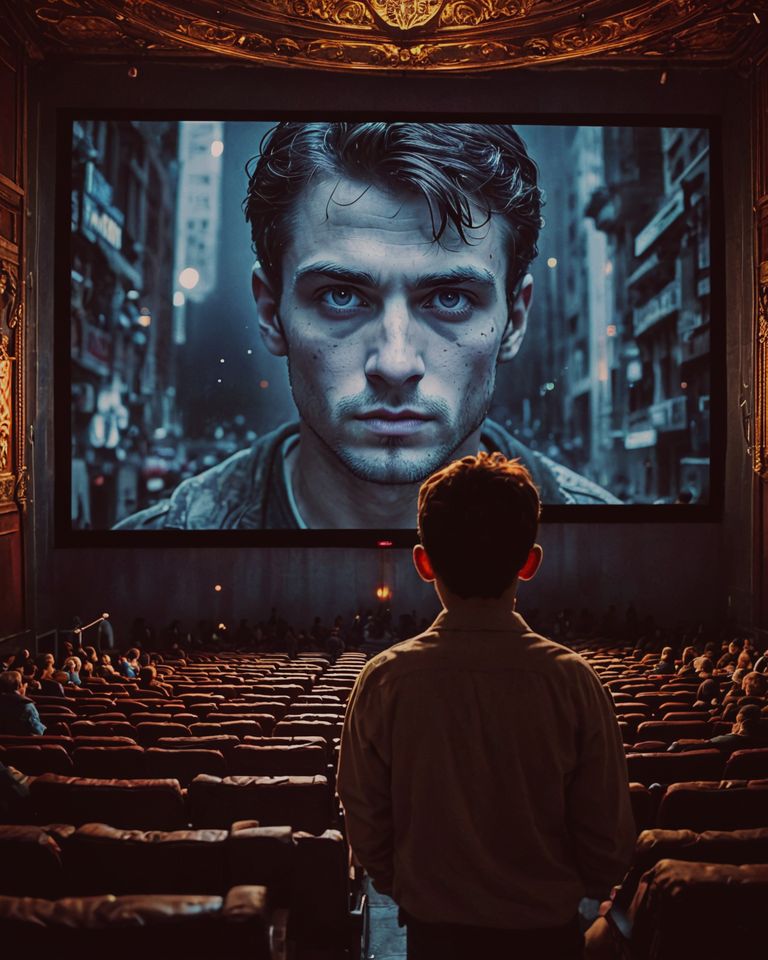
As the movie began to be projected on the giant screen, I couldn't help but remember the magical nights at "The Star". There every screening was a ritual; the sound of the projector turning, the murmur of the audience anticipating what was to come and the unmistakable aroma of freshly made popcorn filling the air. On the other hand, everything here seemed cold and distant; even the surround sound seemed more artificial.
After the show, I decided to propose a toast in honor of the old cinema. "The Star may not have the most advanced technology," I said as I raised my glass in a small coffee shop in the mall where we had gathered after the movie, "but he has something that multiplexes will never be able to match: a story." My friends nodded; Sofia smiled as she reflected on what she had said.
As time passed, I realized that my love for cinema went beyond the simple act of watching movies; I wanted to capture those stories and share them with others. That's how my idea was born: to make a documentary about the evolution of cinema in our town.
I started interviewing people who had passed through "La Estrella", including my grandfather Manuel and other neighbors who had fond memories of the place.
Manuel shared stories about how he went to the cinema when he was young. He talked about the days when movies would be screened for weeks and how that allowed the community to come together again and again to enjoy the same movie. "It was like a ritual”" he would say wistfully. "People would come to laugh or cry together."
Lucas was also part of the documentary; his perspective on the new multiplex was fascinating. He talked about how technology had changed the way we experience cinema: "IMAX screens are amazing; they make you feel like you're inside the movie." However, he also admitted that there was something special about the old wards that could not be replaced.
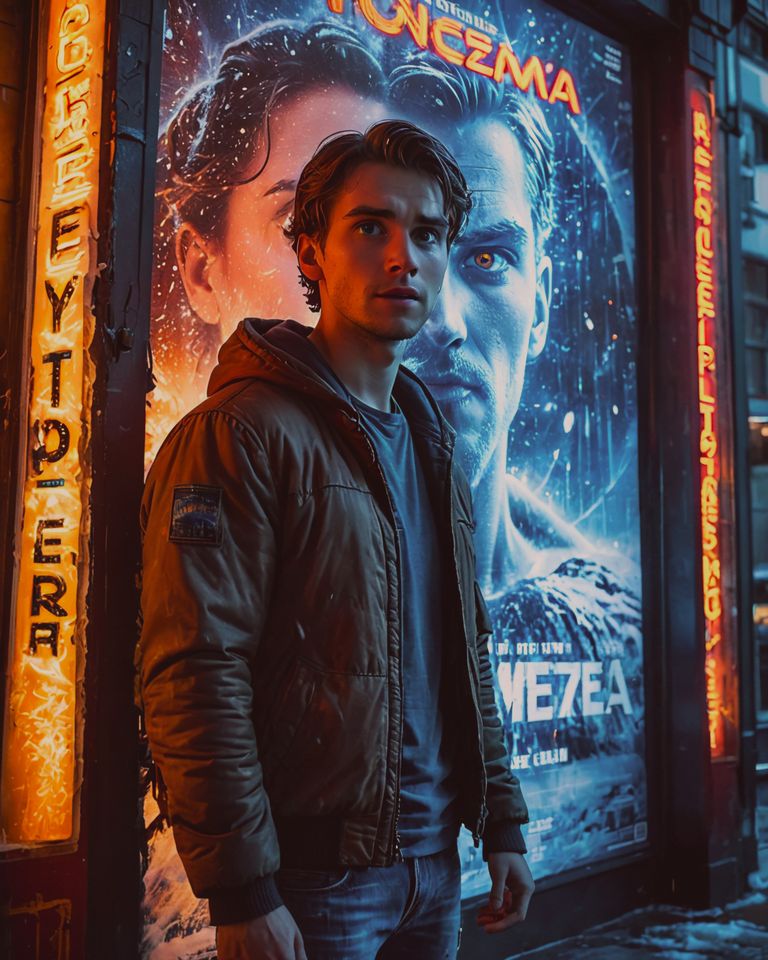
Sofia analyzed how both experiences offered different perspectives on the same cinematographic art. "Cinema is a way of telling stories,” he said as we reviewed the recordings together. "But it's also a way to connect with other people.”
Finally, I decided to organize a special screening at "The Star". I wanted to show my documentary followed by a classic film to celebrate both the old and the new. The news quickly spread through the village; friends and family began to talk about the event.
The day came and the old cinema was full to the brim. The atmosphere was magical; the dim lights illuminated the expectant faces as everyone settled into their seats. After screening my documentary, I presented "Casablanca", a timeless film that had been one of my grandfather's favorites.
At the end of the evening, while everyone was sharing laughs and memories in the lobby of the old cinema, I understood something fundamental: it was not about choosing between the old and the new; both worlds could coexist harmoniously. The essence of cinema lies not only in its technology or its physical presentation; it resides in the stories it tells and the human connections it creates.
With the passage of time, "La Estrella" continued to screen classic films while the new multiplex filled its theaters with the latest releases. I became a renowned local filmmaker advocating to preserve the history of cinema while embracing innovation.
That was how I learned to value both cinematic worlds: one full of nostalgia and human warmth, the other vibrant and innovative. In that small town where two realities coexisted, the memories of the past continued to illuminate the screens of the present, always reminding us that the true art of cinema resides not only in how it is shown but also in how it makes us feel and connect with each other.
Source of the images
Image created with Starryai.
Versión en Español
Desde que tengo memoria, el viejo cine "La Estrella" ha sido mi refugio, un lugar donde los sueños se proyectaban en la pantalla grande y la realidad se desvanecía por un par de horas. Su fachada, desgastada por el tiempo, aún conserva un encanto especial; las paredes de ladrillo rojo y las letras de neón parpadeante cuentan historias de risas, lágrimas y momentos compartidos. Cada rincón de ese cine está impregnado de recuerdos que me conectan con mis raíces y con mi familia.
Mis sábados eran sagrados. Mi abuelo Manuel, un amante del cine clásico, me llevaba a ver las películas que marcaron su juventud. Recuerdo cómo entrábamos juntos al cine, él con su andar pausado y yo emocionada, casi corriendo hacia la taquilla. El olor a palomitas recién hechas nos recibía como un abrazo cálido. Las butacas de terciopelo rojo, aunque un poco desgastadas, eran cómodas y acogedoras. Mientras la luz se atenuaba y el proyector comenzaba a girar, sentía que cada película era una ventana a otro mundo.
Un día, mientras revisaba viejas fotografías del cine en casa, Lucas, mi amigo desde la infancia y un entusiasta de la tecnología, me sorprendió con una noticia que cambiaría todo. "Clara", dijo con una chispa en los ojos, "han abierto un nuevo multicines en el centro comercial. Tienen pantallas IMAX y asientos reclinables. ¡Tienes que ir!". La emoción en su voz era contagiosa, pero al mismo tiempo sentí una punzada de nostalgia. ¿Qué pasaría con "La Estrella"? ¿Podría un nuevo cine competir con los recuerdos que había creado allí?
Decidida a explorar esta nueva experiencia cinematográfica, decidí invitar a mis amigos para que me acompañaran: Sofía, una crítica de cine brillante y siempre dispuesta a compartir sus opiniones incisivas; y Javier, un amante del cine clásico que se resistía a abandonar las viejas salas. Juntos acordamos visitar el nuevo multicines un sábado por la tarde.
Al llegar al centro comercial, mis expectativas eran altas pero también llenas de dudas. La entrada del multicines era imponente; enormes carteles iluminados anunciaban las últimas películas de Hollywood. Al cruzar las puertas automáticas, me encontré en un vestíbulo amplio y moderno donde todo parecía diseñado para impresionar. Las largas filas para comprar entradas habían sido reemplazadas por máquinas automáticas que emitían boletos en segundos. Una gran pantalla digital mostraba los horarios de las funciones y los tráilers de las películas.
"Esto es impresionante", dijo Lucas mientras se acomodaba en su asiento reclinable en la sala de proyección. Miré a mi alrededor; las butacas eran cómodas y espaciosas, pero algo me faltaba. Javier frunció el ceño al ver cómo todos estaban absortos en sus teléfonos antes de que comenzara la película. "No sé... aquí no hay alma", murmuró con desdén.
Mientras la película comenzaba a proyectarse en la pantalla gigante, no podía evitar recordar las noches mágicas en "La Estrella". Allí cada proyección era un ritual; el sonido del proyector girando, el murmullo de la audiencia anticipando lo que estaba por venir y el aroma inconfundible de las palomitas recién hechas llenando el aire. En cambio, aquí todo parecía frío y distante; incluso el sonido envolvente parecía más artificial.
Después de la función, decidí proponer un brindis en honor al viejo cine. "La Estrella puede no tener la tecnología más avanzada", dije mientras levantaba mi vaso en una pequeña cafetería del centro comercial donde nos habíamos reunido después de la película, "pero tiene algo que los multicines nunca podrán igualar: una historia". Mis amigos asintieron; Sofía sonrió mientras reflexionaba sobre lo que había dicho.
Con el paso del tiempo, me di cuenta de que mi amor por el cine iba más allá del simple acto de ver películas; quería capturar esas historias y compartirlas con otros. Así nació mi idea: hacer un documental sobre la evolución del cine en nuestro pueblo.
Empecé a entrevistar a personas que habían pasado por "La Estrella", incluidos mi abuelo Manuel y otros vecinos que tenían recuerdos entrañables del lugar.
Manuel compartió historias sobre cómo él iba al cine cuando era joven. Habló sobre los días en que las películas se proyectaban durante semanas y cómo eso permitía a la comunidad reunirse una y otra vez para disfrutar del mismo filme. “Era como un ritual”, decía con nostalgia. “La gente venía a reírse o llorar juntos”.
Lucas también fue parte del documental; su perspectiva sobre el nuevo multicines era fascinante. Habló sobre cómo la tecnología había cambiado nuestra forma de experimentar el cine: “Las pantallas IMAX son increíbles; te hacen sentir como si estuvieras dentro de la película”. Sin embargo, también admitió que había algo especial en las viejas salas que no podía ser reemplazado.
Sofía analizó cómo ambas experiencias ofrecían diferentes perspectivas sobre el mismo arte cinematográfico. “El cine es una forma de contar historias”, dijo mientras revisábamos las grabaciones juntas. “Pero también es una forma de conectar con otras personas”.
Finalmente, decidí organizar una proyección especial en "La Estrella". Quería mostrar mi documental seguido de una película clásica para celebrar tanto lo antiguo como lo nuevo. La noticia corrió rápidamente por el pueblo; amigos y familiares comenzaron a hablar sobre el evento.
El día llegó y el viejo cine estaba lleno hasta los topes. La atmósfera era mágica; las luces tenues iluminaban los rostros expectantes mientras todos se acomodaban en sus asientos. Después de proyectar mi documental, presenté "Casablanca", una película atemporal que había sido uno de los favoritos de mi abuelo.
Al final de la noche, mientras todos compartían risas y recuerdos en el vestíbulo del viejo cine, comprendí algo fundamental: no se trataba de elegir entre lo antiguo y lo nuevo; ambos mundos podían coexistir armoniosamente. La esencia del cine no radica solo en su tecnología o su presentación física; reside en las historias que cuenta y las conexiones humanas que crea.
Con el paso del tiempo, "La Estrella" continuó proyectando películas clásicas mientras el nuevo multicines llenaba sus salas con los últimos estrenos. Me convertí en una reconocida cineasta local que abogaba por preservar la historia del cine mientras abrazaba la innovación.
Así fue como aprendí a valorar ambos mundos cinematográficos: uno lleno de nostalgia y calidez humana, otro vibrante e innovador. En aquel pequeño pueblo donde dos realidades coexistían, los recuerdos del pasado seguían iluminando las pantallas del presente, recordándonos siempre que el verdadero arte del cine reside no solo en cómo se muestra sino también en cómo nos hace sentir y conectar entre nosotros.
Fuente de las imágenes
Imagen creada con Starryai.